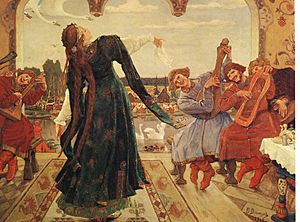The Frog Princess facts for kids

The Frog Princess is a classic fairy tale with many different versions from around the world. It's known as an "animal bride" story, where a human marries an animal who later turns into a person. One famous version of this tale comes from Russia. It's often called Tsarevna Lyagushka (which means "Frog Princess") or Vasilisa Premudraya (meaning "Vasilisa the Wise").
Contents
The Story of the Frog Princess
The story usually begins with a king who wants his three sons to get married. He sets up a special test for them to find their brides.
The King's Challenge
The king tells each prince to shoot an arrow. The rule is simple: wherever the arrow lands, that's where the prince will find his future wife.
- The oldest son's arrow lands at a noblewoman's house.
- The middle son's arrow lands at a wealthy merchant's house.
- The youngest son, Prince Ivan, shoots his arrow, and it lands in a swamp. A frog picks it up! This means the frog is his bride.
Tasks for the Brides
The king then gives his three future daughters-in-law different tasks. These tasks often include spinning cloth or baking bread. In every task, the frog bride does much better than the other two. She often uses magic to complete her tasks perfectly. The other brides try to copy her, but they can't do magic.
The Frog's Secret
Prince Ivan is usually embarrassed by his frog bride. But at night, the frog magically turns into a beautiful human princess. In the Russian versions, this princess is named Vasilisa the Wise. She is smart, kind, and very skilled. She was forced to live as a frog for three years because she disobeyed a powerful, evil wizard named Koschei.
The Prince's Mistake
The king's final test might be a grand banquet or a dance. The Frog Princess sheds her frog skin to dance as a human. But Prince Ivan, impatient to keep her human, burns her frog skin. This is a big mistake! If he had waited, she would have been freed from the spell. Because he burned the skin too soon, she disappears.
Finding Vasilisa the Wise
Prince Ivan then has to go on a long journey to find her again. He often meets a magical old woman called Baba Yaga. She helps him by telling him that Koschei the wizard is holding his bride captive. Baba Yaga explains how to find a special magic needle that is needed to rescue Vasilisa.
Different Versions of the Tale
Many countries have their own versions of the Frog Princess story.
- Andrew Lang included an Italian version called The Frog in his book The Violet Fairy Book.
- Italo Calvino shared another Italian story, The Prince Who Married a Frog, noting that this type of tale was popular all over Europe.
- A Greek version, The Enchanted Lake, was collected by Georgios A. Megas.
These stories often share the main idea of a prince marrying an animal bride who turns into a princess.
Stories Inspired by The Frog Princess
The Frog Princess tale has inspired many films and other works.
Films and Animation
- Vasilisa the Beautiful is a 1939 Soviet film based on the story. It was one of the first big fantasy films made in the Soviet Union.
- In 1954, a popular animated film called The Frog Princess was made by "Soyuzmultfilm".
- Another animated film, also called Vasilisa the Beautiful, was released in 1977.
- A 1996 animated Russian version explained that Princess Vasilisa was kidnapped and cursed by the evil wizard Kashay. Only Prince Ivan's love could free her.
Other Adaptations
- The story was featured in Happily Ever After: Fairy Tales for Every Child, a TV show that retells classic fairy tales.
- In the 2007 comic book Hellboy: Darkness Calls, the character Vasilisa helps Hellboy fight Koschei.
- A Hungarian version of the tale was made into an episode of the TV series Magyar népmesék ("Hungarian Folk Tales"), titled Marci és az elátkozott királylány ("Martin and the Cursed Princess").
Images for kids
-
Illustration to The Frog Tsarevna by Ivan Bilibin
See also
 In Spanish: La princesa rana (cuento) para niños
In Spanish: La princesa rana (cuento) para niños


